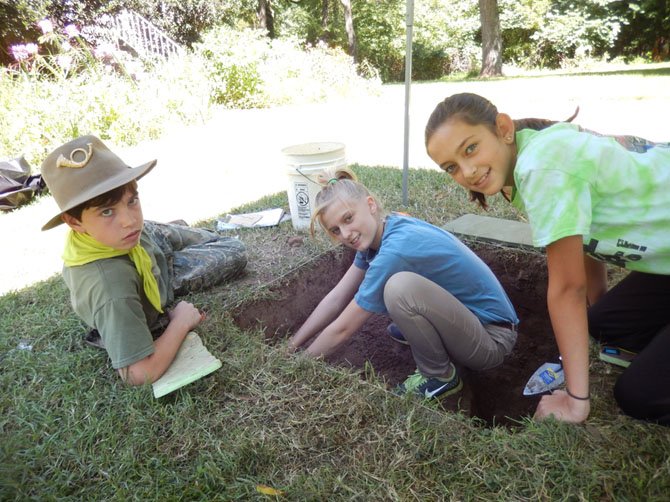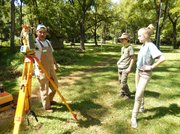(From left) Students James McVicker, Corina Gribble and Haly Yungwirth search for historic artifacts in the ground. Photo by Bonnie Hobbs.
Oakton High junior Corina Gribble got to be part of history recently when she participated in an archaeological dig to find the remains of a home from the 1800s in Ellanor C. Lawrence Park in Centreville.
It’s believed to have been southeast of the stone house that’s now the Walney Visitor Center. But this wood-framed house burned down on Dec. 30, 1874; so under the direction of the Fairfax County Park Authority, students ages 12-16 tried to find evidence of its existence.
“The Park Authority has records of this event, but we don’t know where on the landscape it was,” said E.C. Lawrence Park Manager John Shafer during the dig. “The kids are using a $14,000 piece of survey equipment to go from a control spot to the digging sites so, in the future, people will know exactly where these digs were.”
Then, said Shafer, they’d know where to investigate and search for remnants of the burned home next. “These are windows of information into the past,” he said.
And Gribble, 16, was happy to be part of the experience. “I’ve been wanting to find archaeological things to do, but you had to be 18 for most of them,” she said. “So this was an opportunity to be able to participate in a dig, myself.”
BACK IN THE 1800S, Lewis Machen, who was clerk of the U.S. Senate for 49 years, lived in the old stone house with his wife. But since his job frequently kept him away from home, his son James ran the family’s Walney farm and lived in the wood-framed house with his own family.
“We’ve already done research into historical records and genealogy and found information about that house that James left in a wooden box inside the wall of his parents’ home,” said Shafer.
“It’s our second time digging here,” said the Park Authority’s Megan Veness, who lead the students’ archaeological dig. “Last year, we dug by the old Walney dairy and found stoneware, nails and other things related to daily life in the 1800s. Here, we found some artifacts, but no evidence of the home’s structure.”
Making it tougher, said Shafer, is that “After the fire, James might have cleaned up the area and thrown away the debris from the burned house.”
But, said Veness, “You never know what you’ll find until you start digging.” That’s why the students’ efforts were so valuable.
“It’s not only a chance for us to get the research done, but to expose the kids to applied science,” said Shafer. “Their notes will be part of the official record, so they’ll have their stamp on history. And it gets them involved in managing the resources of their own, county park.”
The story of the fire is both sad and compelling. “James and his wife had eight children, but only four survived to adulthood,” said Shafer. “On Christmas Eve in 1874, James’s 2-year-old daughter, Mary, died. And a week later, the house burned down due to a ‘poorly constructed chimney,’ where the fire started. The family lost nearly everything they had and moved into and expanded the stone house. So we want to know exactly where they were living when the fire happened.”
“We’re now writing a complete human history of life here and how it affected or changed the landscape,” continued Shafer. “We have written records, oral histories and some archaeological artifacts, and now we’re putting it all together.”
DURING THE DIG, said Haly Yungwirth, who’s homeschooled, “We found a lot of clay deposits, but all the stuff we found could be from any time period. For example, we found a plastic lid next to a shard of pottery. So we’re digging the disturbed and undisturbed areas separately, so as not to confuse the time periods.”
“I’ve really enjoyed it,” said Gribble. “It’s fun — slow, but steady work. I like digging, learning how to do archaeology and finding even the smallest piece of pottery. We’ve found ceramics, glass, nails and mortar used with bricks. We also found thin, smooth flakes that we think were created when people were making arrowheads.”
Yungwirth said it was a good opportunity to learn how long an archaeological dig takes and “gives people a more realistic idea of this field before they go into it. It can be exciting if you have the patience for it, and you get to socialize with others.”
“I’ve always found this field interesting, and it’s also a way to experience the history we’ve read about in school,” said Gribble. “You get to dig, find something, hold it and uncover [details about] people’s lives that others haven’t heard about. I’m thinking of going into cultural anthropology — the study of different cultures and how they interacted with other cultures and with their environment — so archaeology goes hand-in-hand with that.”
Park Authority senior archaeologist Christopher Sperling said the students participating in this dig will “hopefully get a better understanding of history, artifacts and how people lived in the 1800s. It’s hands-on history.”
All in all, added Yungwirth, “It’s pretty cool.”


